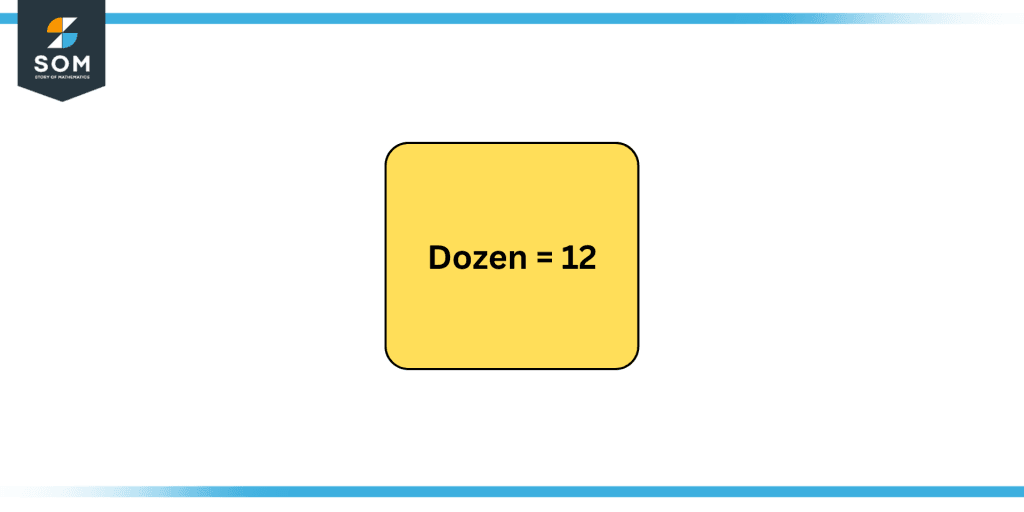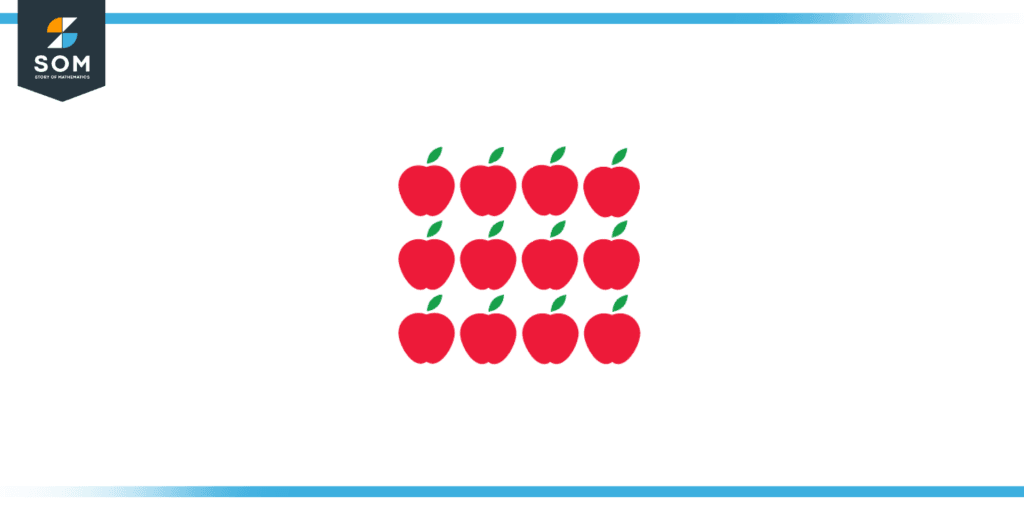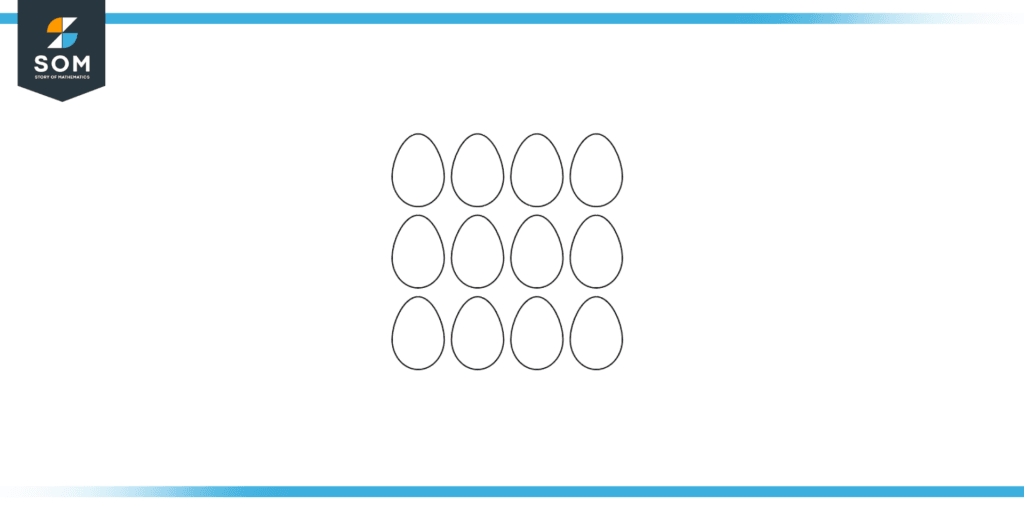JUMP TO TOPIC
Dozen|Definition & Meaning
Definition
Exactly twelve of anything is called a dozen. This term is mostly used in the context of eggs which we usually buy “by the dozen” i.e., in packages of twelve or a dozen eggs.

Figure 1: A dozen is equal to 12.
However, we still use it in the context of fruits and to refer to various groups of twelve. For example, dozen apples.

Figure 2: A dozen apples.
Twelve items make up the measurement of a dozen. Even though it is frequently used in everyday speech, the phrase “a dozen” also has formal and technical uses in areas like math, economics, and baking.
History of the Usage of the Term “Dozen”
One of the oldest used units of measurement is the dozen. The 12-base number system is referred to as duodecimal or dozenal. The practice of using the thumb to count the finger bones is thought to have given rise to it.
It is a part of nature. A year has twelve months, twelve moon cycles, or twelve zodiac signs. A day contains two cycles of 12 hours each.
Ancient civilizations who utilized a duodecimal system for numbering, such as the Babylonians and Egyptians, are where the usage of the number 12 as a base for counting first emerged. Later, the Romans embraced this method, and it spread over all of Europe. The Old French term “douzaine,” which means “a group of 12,” is where the English word “dozen” first appeared.
Use of Dozen in Mathematics
The word “a dozen” is used in mathematics as a unit of measurement for angles. A whole circle has 360 degrees; hence 12 degrees are equal to 30 degrees. The idea of a dozen also lends itself to fundamental mathematics and problem-solving since it offers a framework for counting and organizing objects into groups of 12.
This can be helpful in a variety of mathematical applications, including figuring out how many items make up a group or determining how many items there are overall when multiple sets are joined.
Mathematical computations are also made simpler and clearer by using the unit of measurement of a dozen.
Use of Dozen in Statistics
The term “dozen” is frequently used in statistics as a practical measurement, particularly in data visualization and representation. It is standard procedure in the field of statistics to divide data into groups of twelve since doing so makes the data simpler to comprehend, evaluate, and display in a clear and succinct manner.
For instance, grouping data into dozens in a bar graph or histogram might assist in dividing big datasets into more manageable portions. In this manner, it will be simpler to recognize patterns and trends in the data and to evaluate the connections between various data points.
A graph or chart can be made simpler to read and interpret by grouping data into dozens. This can also aid in the reduction of clutter on the graph or chart.
The computation of the mean and standard deviation is another statistical application of the word “dozen.” To acquire a general idea of the central tendency and variability of the data, a data set can be broken into dozens of smaller groups. This might be helpful for performing a rapid study of the data and can give you a general understanding of the distribution’s basic structure.
As a practical unit of measurement that aids in the simplification and arrangement of enormous amounts of data, the term “dozen” is frequently used in statistics. It is a potent tool that contributes to the enhancement of graphs, charts, and representation, thereby making it easier to comprehend and interpret large data sets.
Use of Dozen in Commerce
As a simple and defined unit of measurement for goods that are frequently sold in groups of twelve, the term “dozen” plays a significant role in commerce. A simple and straightforward way to describe the number of a product being sold or bought, the usage of dozens in commerce facilitates transactions and lessens confusion.
For instance, goods like eggs, donuts, and bagels are widely sold by the dozen in the food business.

Figure 3: A dozen eggs.
As a result, it is simpler for both the supplier and the consumer to comprehend how much merchandise is being swapped. As the price per dozen is typically clearly stated, it also offers a quick way to determine the overall cost of the transaction.
Numerous other businesses also make extensive use of dozens in commerce; thus, it is not just the food industry. For instance, in the retail sector, goods like socks, gloves, and pencils are frequently marketed in dozens, making it simple for customers to buy the quantity they require. The wholesale sector, where vast quantities of products are sold to retailers and other enterprises, is another one where the number of dozens is commonly used in trade.
The use of dozens in commerce not only streamlines transactions and minimizes confusion but also supports uniformity and standards. Businesses can more effectively examine and contrast the costs and quantities of various products by adopting a standardized unit of measurement, which can be helpful when making purchasing choices.
A handy and standardized unit of measurement for items that are commonly sold in groups of twelve is what the term “dozen” serves as in business. The usage of dozens is a crucial instrument in the world of commerce since it facilitates smoother transactions, lessens ambiguity, and fosters uniformity and standardization.
Use of Dozen in Everyday Life
The following are some examples of the term “dozen” used in everyday life:
- A group of 12 players who have received punishment for breaking the rules or acting unethically is referred to as a “dirty dozen” in sports. A squad with 12 players is referred to as a “full dozen,” and 12 points can be scored in a game.
- A “dozen tunes” in music can refer to a group of 12 well-liked or well-known songs. 12 bars of music are referred to as “Taylor’s dozen” in folk music.
- A collection of 12 characters might be referred to as “a dozen” in literature, as in the drama “The Twelve Angry Men.” The phrase can also refer to 12 books, such as those in the “A Dozen Daring Detectives” series.
- A dozen refers to 12 articles of food while cooking or baking, such as a dozen eggs, cookies, or cupcakes. A recipe for a dozen muffins, for example, might use the word to specify how many muffins are included in the recipe.
Summary
In conclusion, the term “a dozen” refers to a measurement unit that is equal to 12 objects. Many ancient cultures employed the number 12 as the basis for counting, and it has been used for many years in disciplines like mathematics, business, athletics, music, literature, and food.
The phrase “a dozen” is a helpful and adaptable approach to describe collections of 12 items, whether it is employed in everyday conversation or technical contexts.
Examples Using the Definition of Dozen
Example 1
Alex purchased three dozen tangerines. What number of tangerines did he buy?
Solution
There are 12 tangerines in each dozen.
Therefore,
3 dozen = 3 x 12
= 36 tangerines
Example 2
For her birthday party, Sasha bought 60 bottles of cold beverages. The bottles arrived in dozen-box sets. How many boxes were there in total?
Solution
Twelve bottles, or a dozen, are contained in each box.
We shall divide 60 by 12 to find the number of dozen there are in 60.
60 ÷ 12 = 5
There were five boxes of bottles as a result.
All images/mathematical drawings were created using GeoGebra.
